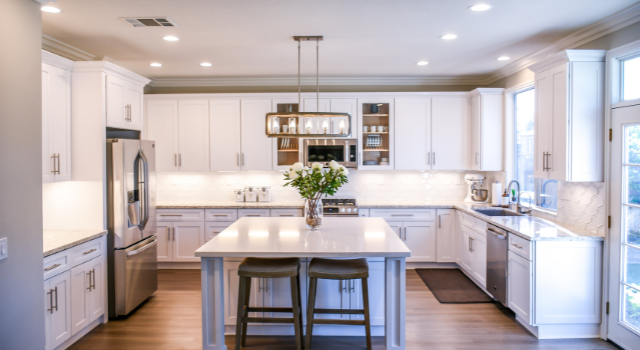A major kitchen remodel can vastly improve the livability of your home and create a more harmonious family life; it can also boost your home’s value, making it easier to sell your property down the line.
At the same time, a successful kitchen renovation requires careful planning and the ability to cut costs without sacrificing quality. Today, we will walk you through the kitchen remodel steps to ensure you enjoy a smooth renovation process and save money at the same time.
Define Your Goals and Budget
Kitchen remodeling projects can be quite expensive, and the cost can quickly spiral out of control if you don’t develop a budget and stick to it. The typical kitchen remodel costs around $27,000, but it can be twice that if you’re redesigning the space entirely and reconfiguring the kitchen’s structure.
Working with a kitchen designer can be incredibly helpful, as they can help you clarify your end goals and develop a plan for how to get there. Some common goals include more storage and square footage, increasing your home’s sale value, or simply updating the aesthetic with new flooring and appliances.
Research and Planning
The kitchen remodeling process truly begins when you start to research and plan. Most people starting a kitchen project will look at photo references of modern kitchens to see what suits their style, then dig into floor plans for their dream kitchen to better understand the steps involved.
Take your time with the planning stage to ensure that you develop a kitchen design that meets your needs, whether that is having large counters for kitchen prep or plenty of storage for your ingredients. You’ll then create a checklist of everything that must be done in your kitchen remodel, such as removing walls in the current kitchen to expand the space or installing new windows.
A designer can help you prevent dead space, such as counters that won’t be easily accessible. They’ll also help you decide on good materials to install and how everything will flow for maximum efficiency in your new space.
Hire Professionals or DIY?
A small remodeling project, like installing ceramic tile on a backsplash or paint touch-ups, can easily be done by the average homeowner. However, when you have more intensive kitchen remodels involving plumbing and electrical work, you must work with a qualified general contractor. Trying to fix these on your own may not only mean your new kitchen isn’t up to code, but it can also result in severe injury or even death.
It’s always best to work with a professional on full kitchen remodeling; thankfully, PacWest Restoration is here to help. Give us a call any time at 503-746-6545 to discuss your home improvement needs, and we’ll assist you in completing a fantastic renovation project that will vastly improve your culinary experience.
Demolish the Old Kitchen
Kitchen remodeling projects that require changing the floor plan will necessitate some demolition. As it can be hard to avoid plumbing and electrical fixtures, you should allow your general contractor to complete this step. They will carefully break down non-load-bearing walls, tear down the drywall, and remove the old materials so that you have an empty room ready to take on all the colors of your imagination.
Gather Necessary Permits
A full remodeling project of any scope will require permits from your city to ensure that everything is done correctly. If you work with a contractor to oversee the overall project, they will be able to manage these for you, leaving you free to focus on picking out all the new materials that will make up your new kitchen.
Order Products
Ordering products for kitchen remodeling projects is often homeowners’ favorite part of the entire process, and it’s not hard to see why. When you get to choose each fixture and faucet, you begin to shape a beautiful new kitchen that truly captures your personality.
Light Fixtures
Even if you have large windows to let in plenty of natural light, good lighting is a must so that you can see what you’re doing, especially in dreary Pacific Northwest winters. Consider adding track lighting above the sink and countertops to better focus light. Many may also install lighting inside cabinets and pantries so they can keep track of their canned goods.
Plumbing Fixtures
A large, ample sink lets you do the dishes with less hassle, while a super-strong sprayer faucet blasts stuck-on food for easier cleaning. You may choose a faucet that has multiple settings depending on what you need, as well as one with an extendable head to bring the spray closer to a dish. Many prefer a swivel tap rather than two taps.
Make sure to have a qualified plumber take a look at your pipes and replace any old fixtures that are reaching the end of their natural life span. If you want to have a fridge with a water dispenser, you’ll need to make sure that you have the lines running to do so.
Custom Cabinets and Appliances
When you install cabinets with additional features, like Lazy Susans and pull-out drawers, you make it that much easier to get the job done right. Look for things like modular compartments that can be rearranged as necessary or stepped drawers that prevent cans or pots from getting lost in the back of the cabinet. A little innovation when setting up your cabinets can save you a lot of trouble down the line.
Appliances
Kitchen remodeling usually involves upgrading appliances as well, which can often be quite pricey if you’re looking at top-of-the-line goods. A ventilation system helps to keep everyone safe when cooking, while a garbage disposal makes it that much easier to clean up after a meal.
You’ll also want to look at a new refrigerator, stove, and dishwasher to truly enjoy your kitchen again. As these involve plumbing and electricity, consult with your contractor to make sure that they will fit in the spaces you have designated for them.
Structural Build Up
This step of the home improvement process will involve the removal and installation of structural elements such as windows, walls, and kitchen islands. This can be complicated if you want to reuse some of the materials, such as a solid surface countertop, and it will need to be done with care so as not to damage any utilities.
Plumbing, Mechanical, and Electrical
Anything involving mechanical, electrical, or plumbing fixtures must be done by a professional for the safety of everyone involved. Your contractor will reroute any electrical or plumbing lines that must be moved, check that your circuits can handle the new appliances, and seal the plumbing so that it won’t leak.
As these parts are completed before the walls are replaced, it’s especially important to get it done right. You may not be able to see a leaking pipe that’s covered by the walls, leading to significant water damage over time.
Walls, Ceilings, and Flooring
Next in the renovation project are the basics of a room. Your contractor will install flooring, walls, and ceilings, including the insulation that will keep your kitchen warm and cozy. The walls and ceilings will typically be made of drywall.
Once you know what your cabinets, fixtures, backsplash, and other elements look like in person and together (as they have hopefully all arrived), you can choose the paint color with more confidence. Prep, prime, and paint anything you need before you install the flooring. Most people choose linoleum or tile for the flooring, as they’re renowned for easy cleanup.
Cabinets, Countertops and Appliances
Once everything’s removed, the contractor will install countertops, appliances, and cabinets, which must be done properly so that they are flush with the wall. While cabinet installation may look easy, the cabinets must be strongly secured to the wall so as to keep them from pulling out when heavy items are placed inside.
You’ll also want to ensure that the countertops are perfectly even, that the dishwasher is on a level surface, and that no hoses or wires have been pinched when placing the refrigerator or stove against the wall.
One of the last major parts of the process is installing the backsplash. With this, your kitchen remodeling project’s almost done!
Final Inspection
Lastly, you get to the final step, which is a last walkthrough of the project by you and the contracting team. The contractor will check that everything has been done to code and that you’re satisfied with the installation. You’ll sign off on the project, and the renovation is complete. You’re now free to put the final touches on your beautifully remodeled kitchen.
When you work with PacWest Restoration, you can be assured that we’ll treat you and your house with the utmost respect. We aim to keep our customers informed throughout the entire remodeling process, and we’ll use efficient, effective methods to keep the cost down.
You can get in touch with us at any time at 503-746-6545 or use our convenient contact form to share your remodeling needs with a consummate professional. We look forward to working with you and creating an inviting culinary space that you’ll love.
FAQs About Kitchen Remodels
What Is a Realistic Budget for a Kitchen Remodel?
Your budget will vary based on exactly how expensive you’d like to customize your kitchen and whether you’re going for a top-of-the-line experience. The average remodel costs about $27,000, but you can certainly go cheaper than this if you are willing to sacrifice some elements.
A budget kitchen will cost between $10,000 and $25,000, while a midrange kitchen remodeling will be somewhere between $26,000 and $50,000. A kitchen beyond $50,000 is considered a luxury kitchen.
In What Order Should You Remodel a Kitchen?
The typical order for a kitchen renovation is as follows:
- Demolition
- Framing, plumbing, and electrical
- Walls, doors, and windows
- Cabinet installation
- Countertops, dishwasher, stove, refrigerator, and fixtures
- Backsplash
- Flooring
- Lighting
Our team at PacWest will help you create the best plan of attack for your remodeling, and we’ll explain our justification for why we would like to do certain projects in a specific order. If you ever have any questions, we encourage you to ask so we can make sure we’re always meeting your needs.
Can I Remodel My Kitchen Myself?
There are parts of a kitchen remodel that you can do on your own, but anything that requires a license to complete properly — namely, electrical, plumbing, carpentry, and mechanical installation — must be done by a professional for your own safety. Any appliance that uses electricity, gas, or water, such as a stove, dishwasher, or refrigerator, should only be installed by professionals who know how to safely connect them to utilities.
If you’re simply doing some minor repairs, such as putting in new flooring or adding a new backsplash, you can certainly take these tasks on yourself.
What Is the Most Expensive Part of a Kitchen Remodel?
Surprisingly, cabinets are usually the most expensive part. This is because they take up most of the real estate in a kitchen, and they are often made to order so as to properly fit in the space. Framing, reinforcing, and attaching them to the wall takes materials, time, and skill to do properly; otherwise, you’ll have your dishes falling to the floor.
How Much Does a Kitchen Remodel Add to Home Value?
Kitchens have some of the greatest return on investment for all remodeling possibilities, adding between 5% and 7% to the overall home value. House hunters want to walk into a welcoming space that has great style and functionality, so it’s no wonder that they are willing to pay top dollar for a kitchen with a good layout, plenty of storage, and the best products that the market has to offer.
What Do You Pick Out First When Remodeling a Kitchen?
You should select your major components first, meaning your layout, any appliance swaps and the cabinets. Next, focus on the lighting, down to the specific finishes and the hardware you want. These elements greatly influence the overall layout, and they often require rewiring or changing the plumbing orientation, so they need to be completed first. After this, you can look at things like countertops and flooring, as they will be installed later.
Should I Replace Countertops or Appliances First?
Most of the time, your appliance selections will need to be placed before countertops, as they are larger and need to be hooked up to utilities. The countertops can wait until everything else is in place, though they are usually put in before the flooring. This also gives you plenty of lead time to find the best marble or granite countertops that money can buy!



